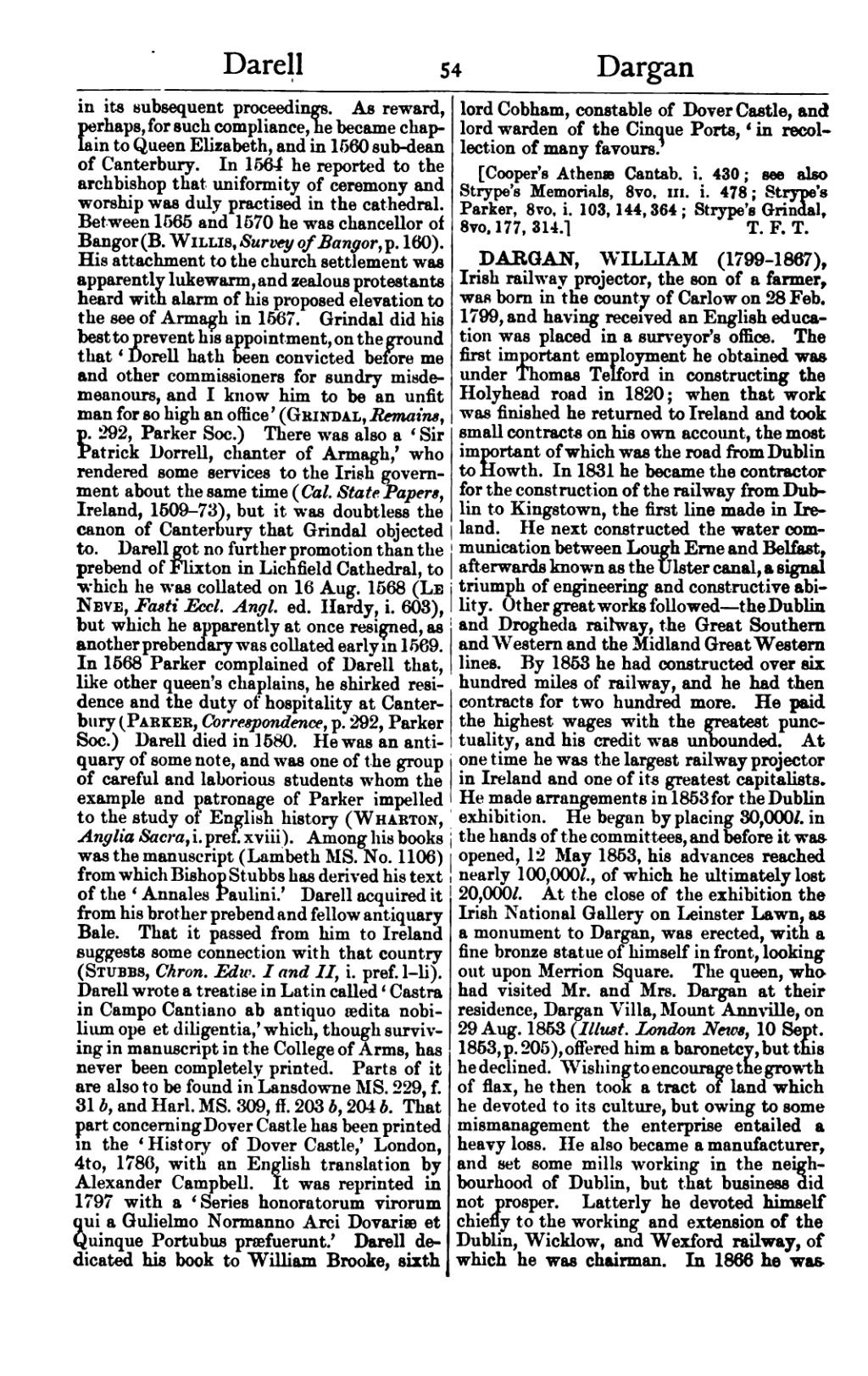in its subsequent proceedings. As reward, perhaps, for such compliance, he became chaplain to Queen Elizabeth, and in 1560 sub-dean of Canterbury. In 1564 he reported to the archbishop that uniformity of ceremony and worship was duly practised in the cathedral. Between 1565 and 1570 he was chancellor of Bangor (B. Willis, Surrey of Bangor, p. 160). His attachment to the church settlement was apparently lukewarm, and zealous protestants heard with alarm of his proposed elevation to the see of Armagh in 1567. Grindal did his best to prevent his appointment, on the ground that ‘Dorell hath been convicted before me and other commissioners for sundry misdemeanours, and I know him to be an unfit man for so high an office’ (Grindal, Remains, p. 292, Parker Soc.). There was also a ‘Sir Patrick Dorrell, chanter of Armagh,’ who rendered some services to the Irish government about the same time (Cal. State Papers, Ireland, 1509–73), but it was doubtless the canon of Canterbury that Grindal objected to. Darell got no further promotion than the prebend of Flixton in Lichfield Cathedral, to which he was collated on 16 Aug. 1568 (Le Neve, Fasti Eccl. Angl. ed. Hardy, i. 603), but which he apparently at once resigned, as another prebendary was collated early in 1569. In 1568 Parker complained of Darell that, like other queen's chaplains, he shirked residence and the duty of hospitality at Canterbury (Parker, Correspondence, p. 292, Parker Soc.) Darell died in 1580. He was an antiquary of some note, and was one of the group of careful and laborious students whom the example and patronage of Parker impelled to the study of English history (Wharton, Anglia Sacra, i. pref. xviii). Among his books was the manuscript (Lambeth MS. No. 1106) from which Bishop Stubbs has derived his text of the ‘Annales Paulini.’ Darell acquired it from his brother prebend and fellow antiquary Bale. That it passed from him to Ireland suggests some connection with that country (Stubbs, Chron. Edw. I and II, i. pref. l–li). Darell wrote a treatise in Latin called ‘Castra in Campo Cantiano ab antiquo ædita nobilium ope et diligentia,’ which, though surviving in manuscript in the College of Arms, has never been completely printed. Parts of it are also to be found in Lansdowne MS. 229, f. 31 b, and Harl. MS. 309, ff. 203 b, 204 b. That part concerning Dover Castle has been printed in the ‘History of Dover Castle,’ London, 4to, 1786, with an English translation by Alexander Campbell. It was reprinted in 1797 with a ‘Series honoratorum virorum qui a Gulielmo Normanno Arci Dovariæ et Quinque Portubus præfuerunt.’ Darell dedicated his book to William Brooke, sixth lord Cobham, constable of Dover Castle, and lord warden of the Cinque Ports, ‘in recollection of many favours.’
[Cooper's Athenæ Cantab. i. 430; see also Strype's Memorials, 8vo, III. i. 478; Strype's Parker, 8vo, i. 103, 144, 364; Strype's Grindal, 8vo, 177, 314.]
DARGAN, WILLIAM (1799–1867), Irish railway projector, the son of a farmer, was born in the county of Carlow on 28 Feb. 1799, and having received an English education was placed in a surveyor's office. The first important employment he obtained was under Thomas Telford in constructing the Holyhead road in 1820; when that work was finished he returned to Ireland and took small contracts on his own account, the most important of which was the road from Dublin to Howth. In 1831 he became the contractor for the construction of the railway from Dublin to Kingstown, the first line made in Ireland. He next constructed the water communication between Lough Erne and Belfast, afterwards known as the Ulster canal, a signal triumph of engineering and constructive ability. Other great works followed—the Dublin and Drogheda railway, the Great Southern and Western and the Midland Great Western lines. By 1853 he had constructed over six hundred miles of railway, and he had then contracts for two hundred more. He paid the highest wages with the greatest punctuality, and his credit was unbounded. At one time he was the largest railway projector in Ireland and one of its greatest capitalists. He made arrangements in 1853 for the Dublin exhibition. He began by placing 30,000l. in the hands of the committees, and before it was opened, 12 May 1853, his advances reached nearly 100,000l., of which he ultimately lost 20,000l. At the close of the exhibition the Irish National Gallery on Leinster Lawn, as a monument to Dargan, was erected, with a fine bronze statue of himself in front, looking out upon Merrion Square. The queen, who had visited Mr. and Mrs. Dargan at their residence, Dargan Villa, Mount Annville, on 29 Aug. 1853 (Illust. London News, 10 Sept. 1853, p. 205), offered him a baronetcy, but this he declined. Wishing to encourage the growth of flax, he then took a tract of land which he devoted to its culture, but owing to some mismanagement the enterprise entailed a heavy loss. He also became a manufacturer, and set some mills working in the neighbourhood of Dublin, but that business did not prosper. Latterly he devoted himself chiefly to the working and extension of the Dublin, Wicklow, and Wexford railway, of which he was chairman. In 1866 he was
